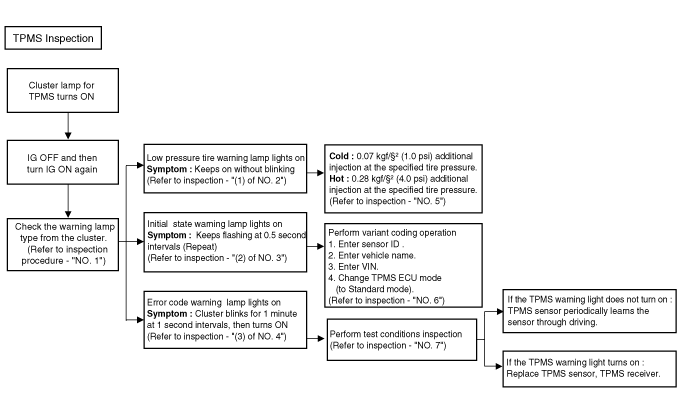List
| symptoms
| Inspection items
| Detailed checklist
| Component/parts
|
C1312(FL)
C1313(FR)
C1314(RL)
C1315(RR)
| TPMS sensor receive error.
| Sensor RF transmission state
| Confirm sensor RF transmission
Check sensor DTC
Inspect Ssnsor battery
| TPMS Sensor
Vehicle electronic units noise
Vehicle operating conditions
|
C1332(FL)
C1333(FR)
C1334(RL)
C1335(RR)
| Sensor internal failure
| Inspect sensor RF transmission
Sensor battery voltage
| Check sensor RF transmission
Check sensor battery (GDS)
| TPMS Sensor
|
C1662
| Auto learning failure
| Sensor RF transmission state
Inspect EMS vehicle speed (VS)
Inspect vehicle noise
| Confirm sensor RF transmission
Inspect sensor battery
Inspect EMS vehicle speed (VS)
Inspect vehicle electronic unit noise
| TPMS Sensor
Vehicle electronic units noise
Vehicle operating condition
EMS vehicle speed signal
|
C1663
| Auto learning failure
| Sensor RF transmission state
Inspect EMS vehicle speed (VS)
Inspect vehicle noise
| Confirm sensor RF transmission
Inspect sensor battery
Inspect EMS vehicle speed (VS)
Inspect vehicle electronic unit noise
| TPMS Sensor
Vehicle electronic units noise
Vehicle operating condition
EMS vehicle speed signal
|
 Kia Sportage: Troubleshooting
Kia Sportage: Troubleshooting
 Description and Operation
Description and Operation TPMS Sensor: Description and Operation
TPMS Sensor: Description and Operation


